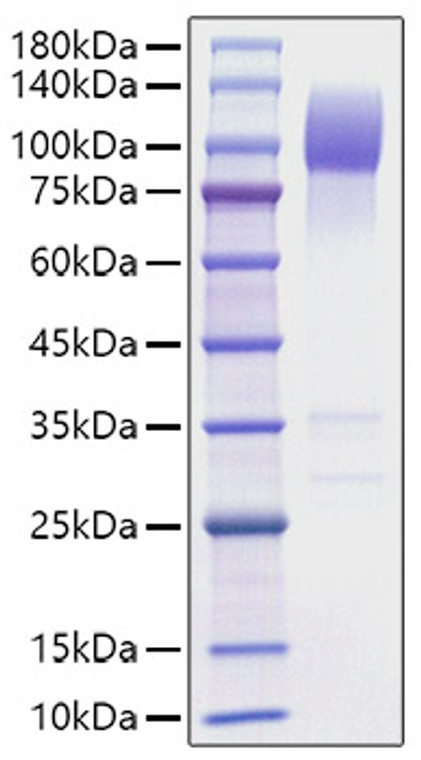| Host: | HEK293 cells |
| Reactivity: | Mouse |
| Note: | STRICTLY FOR FURTHER SCIENTIFIC RESEARCH USE ONLY (RUO). MUST NOT TO BE USED IN DIAGNOSTIC OR THERAPEUTIC APPLICATIONS. |
| Short Description: | Recombinant-Mouse SIRP-alpha/CD172a-C-hFC protein was developed from hek293 cells and has a target region of C-hFC. For use in research applications. |
| Formulation: | Lyophilized from a 0.22 Mu m filtered solution of PBS, pH 7.4. |
| Storage Instruction: | Store at-20°C for up to 1 year from the date of receipt, and avoid repeat freeze-thaw cycles. |
| Immunoreactivity: | Measured by its binding ability in a functional ELISA.Immobilized Human CD47 (Catalog: RP01306) at 2 Mu g/mL (100 Mu L/well) can bind Mouse CD172a (Catalog: RP01619) with a linear range of 1.2-55.3 ng/mL. |
| Gene Symbol: | Sirpa |
| Gene ID: | 19261 |
| Uniprot ID: | SHPS1_MOUSE |
| Immunogen Region: | Lys32-Asn373 |
| Immunogen: | Recombinant Mouse SIRP-alpha/CD172a Protein is produced by HEK293 cells expression system. The target protein is expressed with sequence (Lys32-Asn373) of mouse SIRP-alpha/CD172a (Accession #NP_001277948.1) fused with a hFc tag at the C-terminus. |
| Post Translational Modifications | N-glycosylated. Phosphorylated on tyrosine residues. |
| Function | Immunoglobulin-like cell surface receptor for CD47. Acts as docking protein and induces translocation of PTPN6, PTPN11 and other binding partners from the cytosol to the plasma membrane. Supports adhesion of cerebellar neurons, neurite outgrowth and glial cell attachment. May play a key role in intracellular signaling during synaptogenesis and in synaptic function. Involved in the negative regulation of receptor tyrosine kinase-coupled cellular responses induced by cell adhesion, growth factors or insulin. Mediates negative regulation of phagocytosis, mast cell activation and dendritic cell activation. CD47 binding prevents maturation of immature dendritic cells and inhibits cytokine production by mature dendritic cells. Plays a role in antiviral immunity and limits new world arenavirus infection by decreasing virus internalization. Receptor for THBS1. Interaction with THBS1 stimulates phosphorylation of SIRPA. In response to THBS1, involved in ROS signaling in non-phagocytic cells, stimulating NADPH oxidase-derived ROS production. |
| Protein Name | Tyrosine-Protein Phosphatase Non-Receptor Type Substrate 1 Shp Substrate 1 Shps-1 Brain Ig-Like Molecule With Tyrosine-Based Activation Motifs Bit Cd172 Antigen-Like Family Member A Inhibitory Receptor Shps-1 Myd-1 Antigen Signal-Regulatory Protein Alpha-1 Sirp-Alpha-1 Msirp-Alpha1 P84 Cd Antigen Cd172a |
| Database Links | Reactome: R-MMU-202733 Reactome: -MMU-2172127 Reactome: -MMU-391160 Reactome: -MMU-6798695 |
| Cellular Localisation | Membrane Single-Pass Type I Membrane Protein |
| Alternative Protein Names | Tyrosine-Protein Phosphatase Non-Receptor Type Substrate 1 protein Shp Substrate 1 protein Shps-1 protein Brain Ig-Like Molecule With Tyrosine-Based Activation Motifs protein Bit protein Cd172 Antigen-Like Family Member A protein Inhibitory Receptor Shps-1 protein Myd-1 Antigen protein Signal-Regulatory Protein Alpha-1 protein Sirp-Alpha-1 protein Msirp-Alpha1 protein P84 protein Cd Antigen Cd172a protein Sirpa protein Bit protein Myd1 protein Ptpns1 protein Shps1 protein Sirp protein |
Information sourced from Uniprot.org





